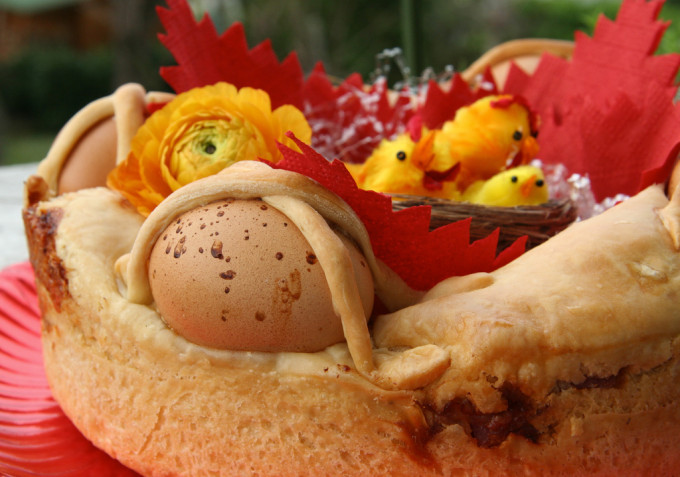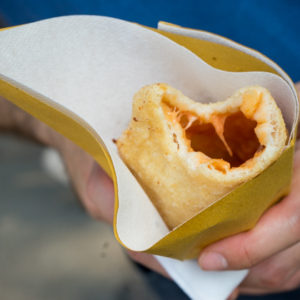The egg is a symbol of Easter because it represents the resurrection of Christ, rebirth and the beginning of Spring. Colourfully painted eggs and chocolate eggs are popular ways of celebrating this festival around the world. In Italy, there are many types of special breads prepared at Easter using eggs, both in the dough and on top in their shell. They can be sweet or savoury. The first one I saw was in Naples and was casatiello baked in the shape of a basket, the bread rich with salami, pancetta and cheese with hard-boiled eggs nestled in the middle of the basket.

Making casatiello by Carmelo Speltino

Casatiello by Mokapest
Another type of Easter bread is cuddhura or scarcella from Puglia, a leavened bread shaped into the form of doves, rings, roosters, baskets, lambs and dolls and topped with hard-boiled eggs. It can also refer to a sweet Easter cake made with lemon zest, anise liqueur and hard-boiled eggs and decorated with confetti sugar.

Cuddhura by SpizzicainSalento
Pizza di Pasqua from Le Marche, meaning “Easter pizza” is also known as crescia di Pasqua and pizza al formaggio, can be either sweet or savoury. It is very similar to pizza di Pasqua from Lazio and pizza al formaggio from Umbria. It is a tall domed bread similar to panettone. They are both made for Easter and are either flavoured with raisins and lemon or citron zest for the sweet version or cheese and pepper for the savoury version. The savoury version is served with salumi and sometimes hard-boiled eggs all over central Italy, particularly for Pasquetta (Easter Monday) when Italians head out of the cities to enjoy picnics with family and friends. Cubed pieces of cheese can be folded into the dough so that the fluffy bread is dotted with globs of molten cheese. Adding a few of these cubes to the top results in a crunchy, perfectly caramelised cheese crust.

Pizza di Pasqua (Easter pizza)
Recipe:
Pizza di Pasqua/ Crescia di Pasqua / Pizza al formaggio (cheese bread) – Le Marche
This bread takes a bit of advance planning but does not take that much time to prepare. For illustrated step-by-step instructions, click here.
900 grams 00 flour
40 grams fresh yeast (can substitute 20 grams dry yeast)
250 ml tepid water
5 grams salt
20 ml olive oil
150 ml tepid milk
4 eggs
160 grams Parmigiano-Reggiano, finely grated
160 grams pecorino, finely grated
5 grams black pepper, freshly ground
160 grams provolone or gruyere, cut in 1 cm cubes
1. Make the biga (for a step-by-step illustrated guide, see here) by dissolving half of the yeast in the water. In a bowl, mix together 450 grams of flour and yeast and water mixture to form a dough. Knead for 5 minutes and form a ball (for a step-by-step illustrated guide, see here). Use a small knife to cut an “X” on the top of the dough. Place the dough in a bowl, cover with cling film and leave it in the refrigerator overnight.
2. Preheat the oven to 200C. Grease a tall (at least 18 cm), straight sided baking tin with olive oil. It is better if it has a removable bottom so you can easily remove the baked bread from the tin.
3. Dissolve the remaining yeast in the tepid milk. Place the flour in a bowl with the salt and olive oil. Add the milk and mix to combine, forming a hard dough.
4. Mix together with the biga made the night before.
5. Shell the eggs, placing them in a bowl. Beat the eggs with a fork and add the grated Parmigiano-Reggiano and Pecorino cheeses. Add this to the dough with the pepper.
6. Add 3/4 of the cubed cheese to the dough and work it in. Place the dough in the prepared tin and dot the top with the remaining cubed cheese.
7. Place the tin in the oven and bake for 1 hour and 15 minutes. Check the bread by poking it through with a wooden skewer. If the skewer comes out clean then the bread is ready to be removed from the oven.
What dishes do you make at Easter? For more about Easter, see here. For a recipe for a traditional Easter pie, see the details on pastiera from Naples here.






Leave a Reply